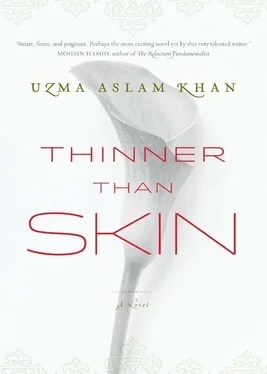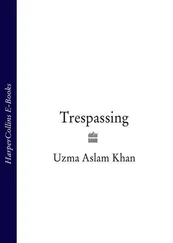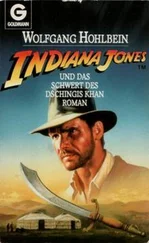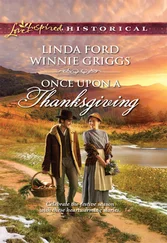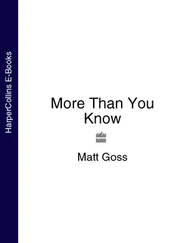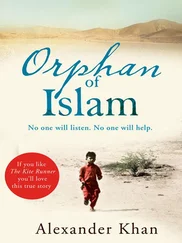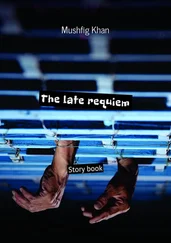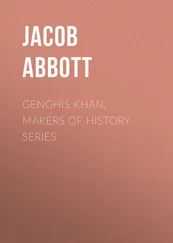I listened closely. Though the shapeshifter had sympathizers in Peshawar and Karachi, no one wanted him here, not even those angered by the missile attacks. What did the people of this valley have to do with it? No, he wasn’t only tracking Intelligence but tracking them — the locals and their very way of life — this snow leopard, this snow leopard’s jinn. And this false trail he was leaving, it was a deliberate distraction from some gargantuan avalanche about to hit those who weren’t looking. The army rangers, Intelligence, and everyone else crawling along the valley’s spine were fools for walking straight into the trap. Or else they were working together, to trap everyone else.
There was a cluster of men in the store now, all debating who was trapping whom, and none answered my greeting. I moved on. A-salaam-o-aleikum , I said, everywhere I went. No one answered. Geography may be an accident but no one in Pakistan ignores a greeting accidentally. I wasn’t deaf, neither to the silence nor the whispers. “It’s him .” Of course they’d heard of Kiran’s death. Of course their eyes were accusing, even if their words were delivered into each other’s collars. But I never got used to it. It’s him . Two words that sent my face igniting in shame. Two words that made me look over my shoulder, again and again, for him : the fraud, the shapeshifter. Two words that made me glad the herders had few friends. For otherwise, I would be dead.
I sought relief by immersing myself in the many murky legends of the valley. The one that preoccupied me most was the legend of Kagan, whose ancestry remained shrouded in secrecy.
Even if Kagan had been related to the pagan Kafir-Kalash tribe of Chitral Valley to the west, fact is, Kaghan Valley existed long before she was born. Before her arrival, the valley had been part of Hazara, whose history was a history of raids. Along the way, the story went, Hazara picked up more names than a pretty girl picks up suitors on her walk home from a well. Under Persian rule, Hazara doubled as Aroosa. Alexander of Macedonia pitched a plundered Aroosa to Raja Ambhi, who renamed her Abhisara. Abhisara next fell to Chandra Gupta, and then to his grandson Asoka. Upon converting to Buddhism, Asoka named the valley “Takht-e-Hazara,” the throne of Hazara, and this must have been its name when Kagan arrived — from Chitral or the Caspian steppe or a fairy world — to wow the people with her beauty and black robes. Perhaps it was Asoka who graced the valley with her name. The details are lost. What remain are a cluster of sacred rocks from Asoka’s day, though this may not be all.
According to Irfan, next to the Asokan rock edicts lay another holy site, a secret one. It was the site of a small cult of worshippers for whom Kagan belonged to another world, a world of animals and spirits. The only way to reach her was through the ancient practice of shamanism. They offered her lavish gifts and asked for her aid in keeping jealous jinns away from their homes, and their romances.
Though it was not possible to ask openly about the existence of the site, I could look for it. I took a bus down to Mansehra, near the site of the rocks, unsure how to begin. What did a secret pagan shrine look like? The bus had to pass Balakot, near where Kiran would now be buried, and her family would still be grieving. When we stopped in Balakot, I sloped into my seat. Thankfully, people got off but no one got on.
The Asokan edicts were engraved on three large boulders. I spent the afternoon photographing them, and the grove of blue pine and deodar trees on the stony slopes not far away. At the grove, I dug around discreetly, looking for evidence of goddess worship: burned incense; a small idol; flower petals. I found none. I walked back to the boulders for a last view of the edicts before heading back to Naran. That’s when I noticed the children racing up the hill toward me. I hesitated. I continued photographing the rocks. The younger ones giggled, standing next to the rocks so they could also be in the frame. The older boys were more reserved. One of them, his head shaved and covered in a pristine white skull cap, whispered to another, in Urdu, so I could understand, though by now I’d know it in any tongue, “It’s him.”
I was surprised they’d heard about it even as far south as here, in Mansehra, which fell outside the valley.
The younger boy whispered back, “You mean Fareebi?”
And the older one replied, “No. I mean the killer.”
I was considered even worse than the hotel bomber!
I turned around and headed back toward the bus stop. They followed me, a long line of boys, the older ones with hands behind their backs, the younger ones skipping ahead, brandishing sticks, their giggles turning malicious in the blood-red evening.
The bus was getting ready to leave. I raced toward it, only adding to my shame. The boys raced after me. With a chewed end of a pencil, the bus driver was twirling the tape back into a cassette; he didn’t look up at the sound of the jeering crowd. As I stepped on the bus, a shadow slid just beyond the corner of my left eye. I paused, right foot on one step, left foot in the air. The specter slid between the boys: a green satin shalwar, a head of light tawny-blonde hair. As the head turned to face me, I ducked into the bus.
The next day, I stayed in the valley. I told no one what I’d seen the previous day, while hurrying onto the bus. Her , or someone like her. Someone who wore the same green pants. There was nothing special about the pants, and many girls had her hair color. It could also be that I was only imagining it. If I’d thought to photograph her — or it — specters do not have sex — the screen would have come up blank. Just as it had the night before we trekked to the lake. But that vision had been real … I had no idea where my thoughts were leading me and didn’t particularly care to chase after them.
Does a man know when he begins to unravel?
I walked south to the next town, the town of Kaghan, where Kagan was believed to have died. Why did I care? I did not know. It was a long walk. It was the graves dotting the roadside between Naran and Kaghan that I had to see. I had to go there. I did not know why. If I had to find an explanation, I’d say it was a call. It was how I’d felt the night before heading to the lake, when I’d run beside the River Kunhar, and that wretched owl with the girl’s face had cried shreet! I did not want to answer, yet I kept walking.
The graves were said to date from soon after the arrival of Islam, when the people converted willingly or by force, depending on whom you asked. There was a time when some might have said it was by force; not now. Nor would they risk acknowledging a pagan site. I felt their fear as I approached the graves. When I reached them, I saw immediately that the headstones were unlike any Islamic graves I’d seen. The first I came across had two birds joined by a floral wreath. The pattern resembled a peace sign, except the “doves” were more like ducks, with flat, wide beaks. There was a date, too faint to read. I passed a dozen others that were similar, with drawings better preserved than a date or a name. There were also headstones with horses — some arching beautifully toward the sky — pulling chariots of clearly defined wheels. Then came a whole series of headstones engraved with owls. Dozens of owls, some with wings in astonishing detail, others with heart-shaped faces intricately carved, the eyes large and fierce.
I took multiple shots of the graves. If the owls vanished from my screen, I’d know I was going insane. Irfan would help, if not with warm stones, then some other magic. Shouting, perhaps. Or a good punch.
Children found me here too. It was almost exactly a replay of yesterday. The younger ones giggled, following me around the headstones, pointing out others with owls. They caught on quickly that these interested me most. But the older boys, once again, stayed aloof. This time it was a boy without a cap and with hair about two days old who did the honors. “It’s him .”
Читать дальше
